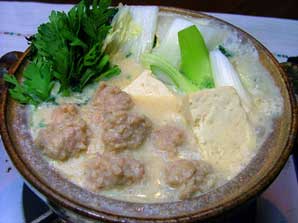Web Japan > Trends in Japan > Lifestyle > Hotpots for Health and Beauty
Hotpots for Health and Beauty
Soymilk and Collagen and Tomato Feature in New Varieties of Nabe
No dish is better suited to Japan's cold winter nights than the nabe, or hotpot. Sitting with friends and family around a simmering pot full of vegetables, fish, and meat has been a favorite wintertime activity of the Japanese for generations. Boiling softens the fibers in the vegetables, making it easier to gobble up large, healthy portions of the nutrients they contain, while the bubbling soup soaks up vitamins and minerals from the meat and fish and is full of nutritious goodness. The combination of piping hot food and lively conversation warms both body and soul and makes the nabe perfect for get-togethers with friends and family.
The Anti-Aging HotpotThe most popular soup bases have traditionally consisted of kombu (kelp) stock with soy sauce, salt, or miso, but there are no hard and fast rules, and different kinds of nabe exist from region to region and from family to family. Enjoying a huge wave of popularity at the moment are several new types of nabe with soups containing collagen, soymilk, or tomatoes. Many of the new varieties promise health and beauty benefits as well as a tasty meal. Initially popular mostly with women, the health-giving benefits of these new dishes—which are purported to give a much-needed boost of energy to tired bodies and minds—have made the new nabe popular with men as well.
Collagen is a type of protein that helps to build skin and connective muscle tissues in animals. Claims that age-related sagging of the skin is caused by a drop in collagen levels have led to a huge surge in demand for collagen-rich cosmetics and health foods. Nobody knows for certain yet whether applying or consuming collagen in this way can actually help to boost the body's own levels of the precious elixir, but the promise that these products might offer a shortcut to wrinkle-free and youthful-looking skin has seen them welcomed by many women. Whatever the scientific evidence, the feeling you get when you sit down to enjoy a creamy, collagen-rich hotpot is that it must be good for you.
The collagen hotpot boom kicked off when a restaurant introduced a "Beauty Nabe" hotpot featuring collagen extracted from chicken bones. Other restaurants followed suit, and before long collagen-based hotpots had become a nationwide craze. Food manufacturers picked up on the trend, and a variety of bottled collagen stock flooded onto the market. These have become a popular choice for people wanting to enjoy nabe at home.
A traditional nabe consists of generous helpings of vegetables, fish, and meat simmered together in broth. It is well known for its nutritional benefits. Whatever the role of collagen may be, one thing is beyond dispute: The nabe is in a class of its own when it comes to providing a hearty, nutritionally balanced meal.
The Birth of the Tomato HotpotThe tomato nabe provides a new, vegetable-rich twist on the traditional dish. Often seasoned Italian-style with olive oil and white wine, the ingredients of tomato nabe generally include shrimp, squid, wiener sausages, and mushrooms. The base of the soup is made from crushed tomatoes, providing a unique and delicious combination of sweetness and rich, full-bodied flavor. Adding rice at the end produces a dish similar to ketchup-flavored chicken rice, while the use of such varied ingredients mirrors some of the combinations used in pasta or pizza dishes. Tomato hotpots can also be accented with Japanese-style seasonings.
Another healthy option proving a firm favorite in the nation's restaurants and homes is the soymilk nabe, which combines the delicate, subtle flavor of soymilk with the richness of vegetables, chicken, and other ingredients. Many people like to add miso paste or sesame for an extra twist. It is the freedom of hotpots that makes them so much fun. There is no need to follow a recipe. You can add anything you want, and use whatever flavoring or stock takes your fancy. The culture of nabe is all about enjoying a delicious mix of different ingredients. It is a dish that never stops evolving. (March 2010)
- B-Grade Cuisine Gets an "A" for Taste (January 2010)
- Vegetable Innovation (August 2009)



